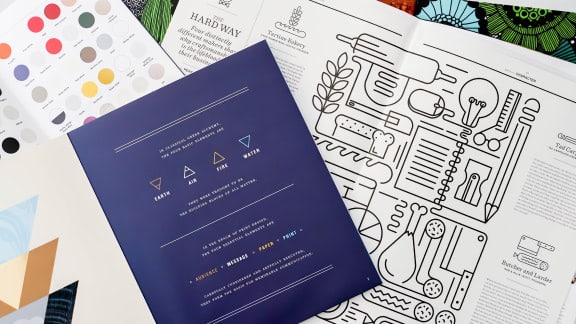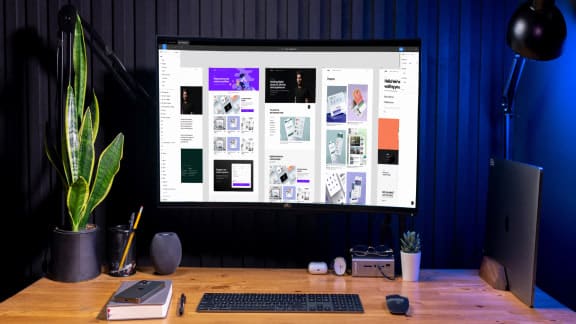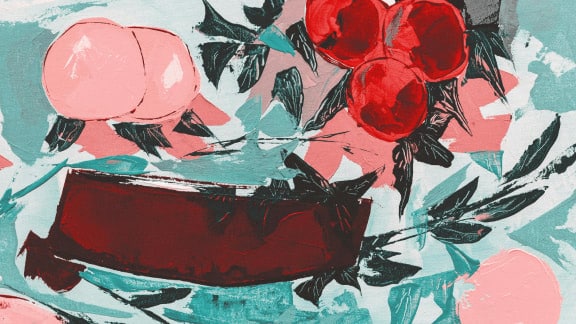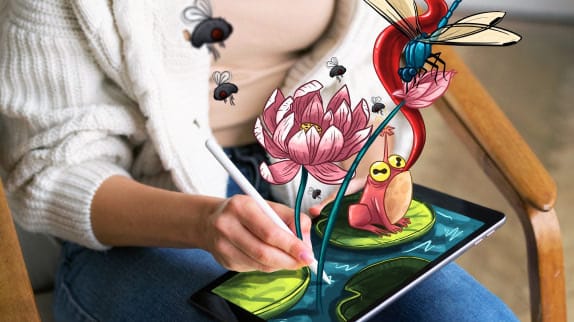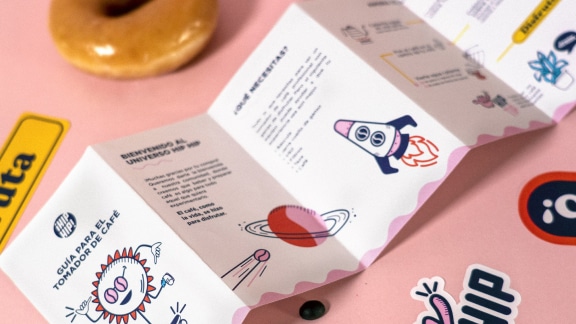Here’s How to Create an Illustration Portfolio That Clients Love
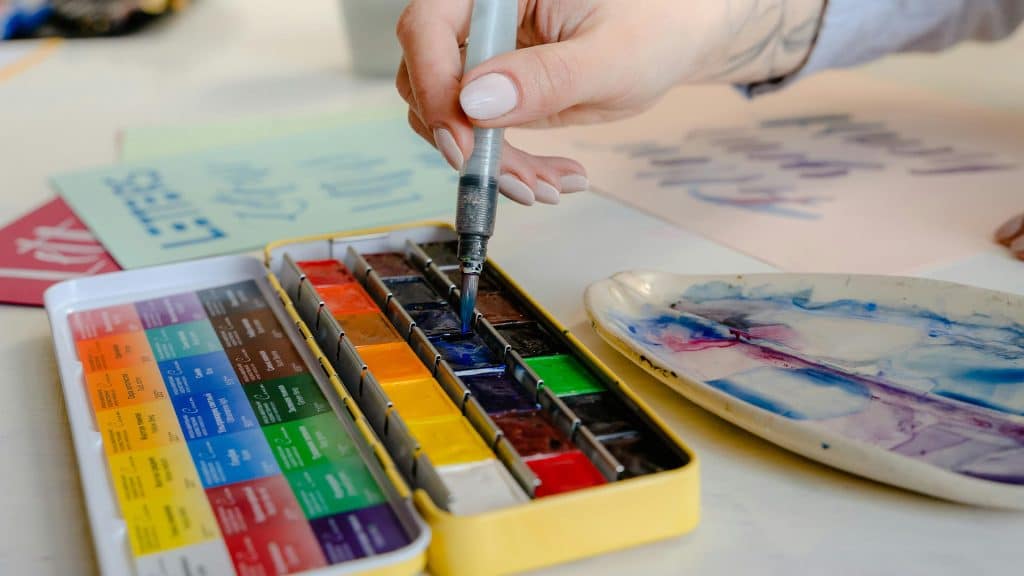
Whether you’re an aspiring illustrator or a seasoned professional, you spend a lot of time perfecting your art. You might spend weeks working on commissions for clients, or maybe you’ve invented fantastic landscapes and quirky characters. These illustrations aren’t just cool pieces of art—they’re a testament to your creativity and skill.
Creating an online illustration portfolio lets you showcase your best work to potential clients and collaborators. It helps them understand your abilities and imagine how you might work together. A portfolio is also a great way to build a loyal fan base. Visitors can explore your artwork and learn what you’re all about through your descriptions and stories.
Designing a portfolio may seem complicated, but you don’t need a background in computer science to get started. This guide breaks down everything you need to know about how to create an illustration portfolio, from choosing the right artwork to getting feedback.
IN THIS GUIDE:
Why Create an Illustration Portfolio
Defining Your Personal Brand
Tips for Getting Started
Building Your Online Illustration Portfolio
Getting Feedback
Promoting Your Portfolio
Illustration Portfolio FAQs
Why Create an Illustration Portfolio
At first, an illustration portfolio might seem unnecessary, especially if you’re at the beginning of your career. You might wonder, “Is my artwork good enough to share online? And would anyone even look at it?”
Contrary to popular belief, portfolios aren’t just for big-name illustrators or professionals with decades of experience. They have many practical purposes for people at all career stages.
Most obviously, an illustration portfolio is a powerful marketing tool. Clients want to see your art style and assess your skills before they hire you. A portfolio allows them to explore your best work without needing to contact you directly to request samples. That way, you can make a great impression right off the bat.
A portfolio also helps you attract the types of projects you want to work on. Do you love illustrating whimsical picture books? By filling your portfolio with illustrations of cute characters and magical scenes, you can connect with authors and publishers working on similar projects. Or maybe you specialize in commercial illustration and prefer to draw artwork for packaging. Showcasing polished brand designs in your portfolio can help you appeal to businesses looking for a professional illustrator.
Additionally, creating an illustrator portfolio is a great way to build your online presence. Many people use search engines to look up artists, either to hire them for projects or just to check out their work. A well-designed portfolio makes it easy for them to find your art and—assuming they love it—get in touch.
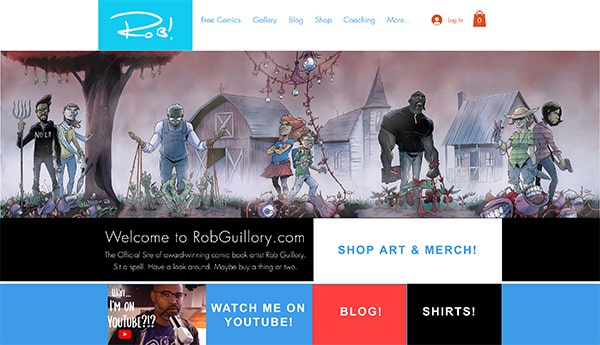
Plus, an illustration portfolio can help you market prints and other products. For example, the cartoonist Rob Guillory has a website that includes a gallery of his vibrant and surreal illustrations. The portfolio links to Guillory’s online shop, which sells custom prints and other merchandise. This strategy could boost your sales by channeling traffic from your portfolio to your online store.
On a personal level, a portfolio allows you to track your progress over time. As you add works to your online gallery, you’ll watch your skills and style develop in exciting and often unexpected ways. Seeing this growth is incredibly satisfying and can give you the push you need to keep leveling up.
Defining Your Personal Brand
Before you start planning your online portfolio, take the time to establish your personal brand. This is more than just a logo or a specific color palette—it’s your unique artistic identity. Your personal brand is how you represent yourself and your work to clients and fans.
For illustrators, a personal brand combines:
- Illustration style
- Personality
- Story
- Values
Start by identifying your preferred aesthetic. While many illustrators have versatile styles, you probably gravitate toward one the most. For instance, you might be a master of funky caricatures or have an obsession with abstract illustrations. By highlighting your signature style in your portfolio, you can attract clients with the right projects.
Your personal brand also includes your personality and values. You don’t have to reveal everything about yourself—a portfolio should be professional, after all—but feel free to include elements to help visitors get to know you. This could involve anything from an illustration of your cat to behind-the-scenes insights into your creative process. For instance, illustrator Sara Fabrizi’s portfolio features “Paint With Me” videos showing how she creates her artwork. Thoughtful touches like these can make your portfolio feel more authentic and engaging.
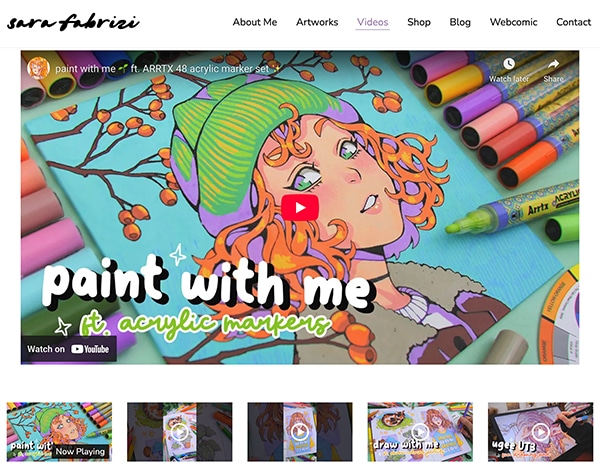
Finally, your personal brand tells your story. For example, you might highlight your passion for exploring new technologies or using your illustrations to advocate for environmental justice. Your portfolio is the perfect place to shape this narrative by displaying the pieces and themes that reflect your artistic journey and passions.
Tips for Getting Started
Your illustration portfolio is a public gallery that anyone can peruse. It should represent your best work and showcase your unique talents. Here are our top tips for designing the perfect portfolio.
#1. Choose Between Online and Physical Formats
There’s no one-size-fits-all approach to designing an illustration portfolio. Some artists prefer the convenience of online portfolios, while others swear by their physical ones. Each format comes with different benefits and drawbacks, so weigh your options carefully.
Illustration portfolio websites are incredibly accessible and let you display as many types of projects as you’d like. For example, you might create separate web pages to spotlight your comics and picture book illustrations. It’s also easy to update a digital portfolio with new projects, so your portfolio will always feel fresh and relevant.
However, you’ll need some basic technical expertise to build a digital portfolio. While most platforms are user-friendly, people who aren’t tech-savvy might face a small learning curve. Additionally, online portfolios can experience technical glitches that can make them difficult to navigate. If you don’t check your portfolio often, you might not notice issues like your website going down.
On the other hand, a physical portfolio allows you to display printed or handmade illustrations. This format can feel much more personal than skimming a website. After all, there’s just something magical about the feel and smell of real paper.
A physical portfolio also gives your audience the chance to study the fine details of your illustrations up close. Plus, you don’t have to worry about technical issues—like an unstable internet connection or sluggish loading times—during in-person interviews or reviews.
Of course, a physical portfolio will have a much smaller audience than an online one. As a result, it could be more challenging for you to connect with clients and fans from other parts of the world. This format is also easier to damage or destroy. If you’re not careful, a spilled cup of coffee or a sudden downpour could leave you with soggy, ruined artwork. If you go this route, always create backups of your physical portfolio, just in case.
#2. Ensure Cohesion and Diversity in Subject Matter
If you want to learn how to build an illustration portfolio, picking the best pieces is key. You might feel tempted to include as many illustrations as possible, but resist the urge. Most artists experiment with different styles and themes, but a jam-packed portfolio can quickly turn into a confusing mish-mash.
Instead, choose portfolio pieces that are both cohesive and diverse. This might seem paradoxical at first, but it’s about striking the right balance. Your illustrations should have a consistent style that fits your personal brand, but they should also demonstrate your range as an artist. In other words, you should pick pieces with diverse subjects and formats, but they should all fit your personal brand.
Many illustrators group pieces by project type or subject matter. Philippines-based illustrator Kerby Rosanes’s portfolio is a great example to use as inspiration. He sorts his artwork into many categories, such as “Creature Illustrations” and “Sperry x Kerby.” This artwork spans many projects—from personal drawings to book illustrations to brand collaborations—but they all have the same fantastical, black-and-white style. This format makes it easy for visitors to understand Rosanes’s personal brand and see what he can do.
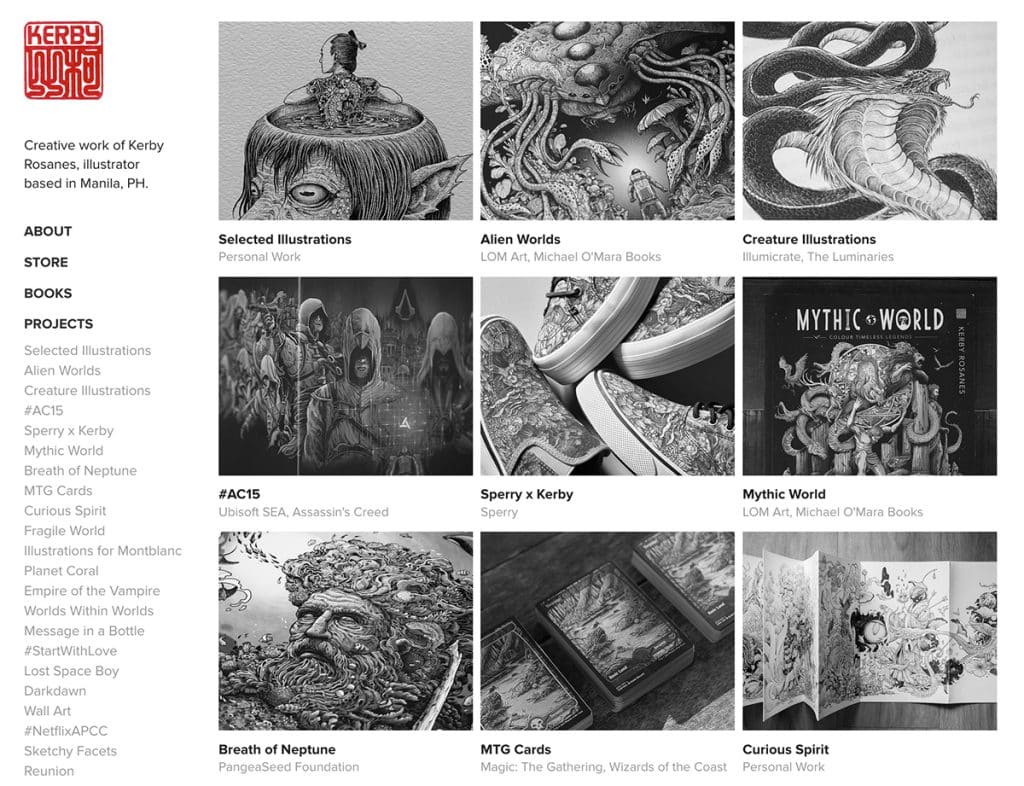
You could also organize your portfolio by medium or technique. For instance, you might include a section for watercolor illustrations and another for caricatures. This approach is helpful for clients who are interested in specific methods. It also lets you show off your versatility as an artist, which may pleasantly surprise visitors who only know one aspect of your work.
No matter which structure you choose, make sure all your illustrations fit your personal brand. If you’ve made a name for yourself as a horror comics illustrator, don’t add that cheerful soap packaging you designed as a one-off project. Doing so will only confuse your audience and muddle your brand. Remember, consistency is key to building your reputation.
#3. Highlight Your Unique Illustration Style
Professional illustrators typically have unique styles that help them stand out from other artists. For example, Oliver Jeffers is known for his simplistic characters and expressive, hand-drawn lines. Meanwhile, Melinda Beck often draws black silhouettes with intricately curved lines and fairytale symbolism. These characteristics appear consistently in their artwork across projects and mediums, making their pieces instantly recognizable.
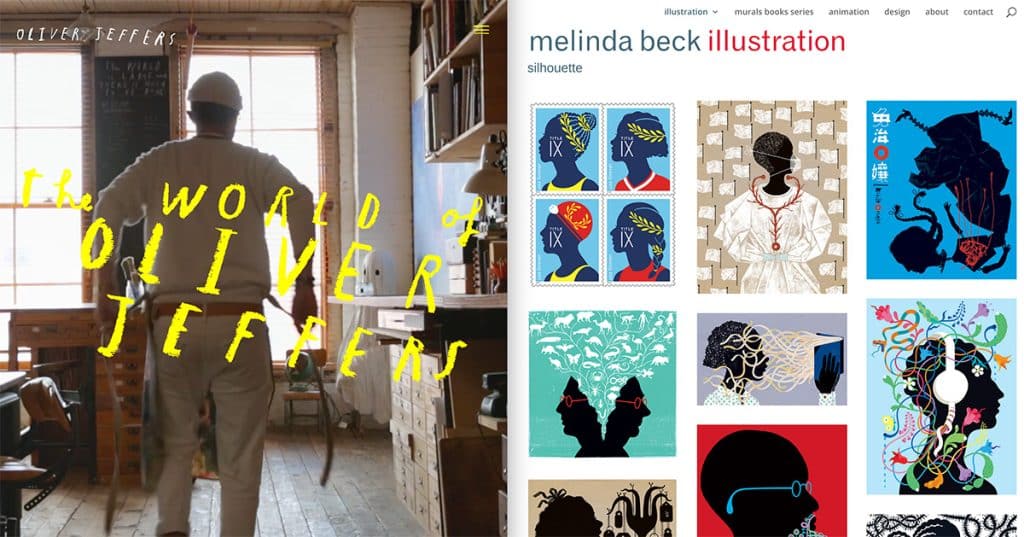
If you’re in the early stages of your career, you might still be developing your illustration style. That’s totally fine! Feel free to include experimental pieces in your portfolio, but try to have some point of cohesion. For example, you might use soft watercolors for all your illustrations or have similar line work. As your style evolves, you can update your portfolio to reflect these changes.
Your portfolio pieces aren’t the only place to show off your illustration style. If you create an online portfolio, you can also draw on your aesthetic for your web design. Consider sketching an avatar of yourself for your “About Me” page or designing a logo in your style. These playful elements give you more opportunities to display your talent and will make your online portfolio feel more cohesive.
#4. Include Case Studies
Case studies are one of the most effective ways to show the impact of your work. These stories describe the entire process of developing an illustration project, from conception to publication. They build your credibility by demonstrating your expertise and professionalism.
Every case study should start with relevant context. Set the stage by explaining the background of the project and when you worked on it. You should also briefly introduce your client and explain their goals. Did they want you to target a specific audience or work in a specific medium? Did you have to juggle competing demands or tricky project requirements? Sharing these details will give your audience deeper insights into the project’s requirements and constraints.
The meat of your case study, so to speak, should be a thorough explanation of your creative process. This is where you explain how the magic happens — how you transformed the client’s vision into beautiful illustrations. Include plenty of in-progress drafts to show how the project evolved from start to finish. By documenting this process, you’ll showcase your artistic and problem-solving skills to potential clients.
Finally, share the project’s results. This might include glowing reviews of your illustrated picture book or awards you’ve won. If you’ve worked on commercial projects, you might describe how your illustrations boosted sales or increased brand recognition. These achievements can make your work more appealing to people who are considering hiring or collaborating with you.
What if you haven’t worked with any clients yet? Don’t worry! You can always include case studies from your illustration courses or more complex personal projects. The main goal is to show how you handle large-scale projects, even if they’re unpaid or self-directed. That way, your audience can understand your skills and ability to tackle creative challenges.
#5. Incorporate Commissioned Projects
Showcasing your commissioned projects is another excellent way to strengthen your credibility and reputation. These pieces demonstrate that clients believe in your skills and appreciate your style enough to pay for custom artwork. In other words, they provide powerful social proof of your illustration abilities.
For example, the Swiss illustrator Evelyne Park features many commissions in her portfolio. She specializes in fantasy art and often draws custom characters and maps. Her portfolio includes in-progress sketches and the final products, making it easy for potential customers to understand her creative process and artistic capabilities.
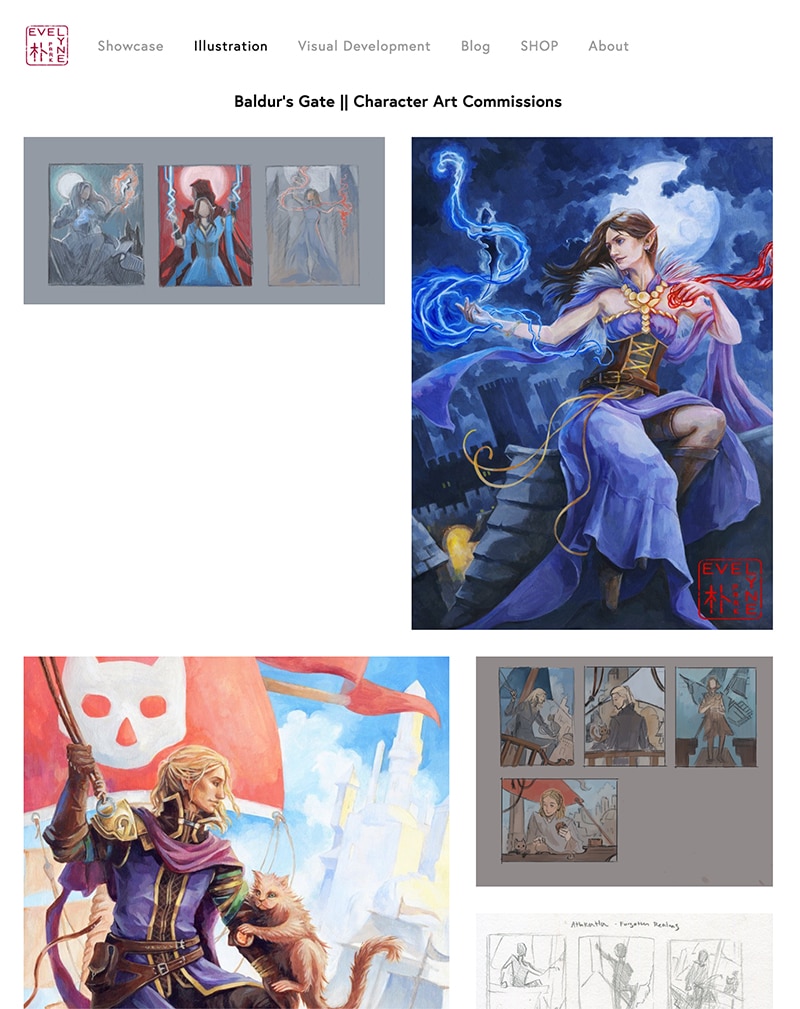
By spotlighting commissioned projects, you’ll demonstrate your ability to work on diverse projects and meet client expectations. These pieces can also help you attract more opportunities. After all, customers are more likely to hire artists if they feel confident they can deliver the results they need.
Of course, you should always ask clients for permission before publishing their commissioned projects in your portfolio. Some illustrators include this request in their contracts, while others ask after delivering the final project. Always get explicit permission in writing, and express gratitude for clients who let you share their commissions.
Building Your Online Illustration Portfolio
At this point, you likely have a sense of the specific pieces and projects you want to highlight in your portfolio. Now, it’s time to pull everything together in a beautiful, polished website.
Luckily, you don’t need to learn how to code or hire a professional web designer to get started. With the right resources—and a little patience—anyone can learn how to make a portfolio for illustration. Follow these easy steps to get started.
Choose the Right Portfolio-Building Platform
You don’t need to build your illustration portfolio from scratch. Many platforms allow users to build professional portfolios with customizable templates and other convenient features. Here are a few popular choices:
- WordPress: This versatile platform is a top choice among professional artists, and for good reason. It offers dozens of ready-made portfolio themes, making it easy for anyone to create a polished website. Just pick the theme that fits your vibe and customize it with text, images, and other content. For more creative control, you can use the drag-and-drop builder to build an entirely bespoke portfolio.
- Wix: Think of this platform as a more accessible alternative to WordPress. It’s incredibly user-friendly and perfect for designing simple portfolios. Wix also features an innovative artificial intelligence (AI) web builder, allowing you to design a stunning portfolio quickly. However, it offers fewer customization options than WordPress, so it’s ideal for people who don’t want to get too high-tech.
- Canva: If you want to avoid the hassle of web hosting, consider Canva’s portfolio website builder. This free tool lets you create a one-page portfolio website and publish it to the web in minutes. Canva offers hundreds of mobile-responsive portfolio templates, and you can even turn the online version into a printed photo book. If you’re torn between a physical and online portfolio, this platform can give you the best of both worlds.
All three platforms offer free resources and tutorials to help you get started.
Maintain a Clean and Organized Layout
Your portfolio pieces are the centerpiece of your website. A clean layout will help your art stand out and make it easy for visitors to explore your work. Choose a neutral color for the background—white is traditional but certainly not the only option—and use a clearly legible font. These elements will allow your audience to focus on what really matters: your awesome illustrations.
A well-organized structure will also make your portfolio more appealing to visitors. Consider creating multiple web pages for different project types or subject matters. Within each page, add explanatory headings and subheadings as needed. That way, your portfolio will feel intentional and neat, not like a random jumble of illustrations.
Regularly Update Your Portfolio
Your illustrations will naturally improve over time as you keep practicing and experimenting with new techniques. Make sure your portfolio reflects this progress by updating it frequently. Add any major projects that you work on, along with exciting commissions (with permission).
Trimming your portfolio is just as important as expanding it. After all, even the most dedicated fans don’t want to sift through hundreds or thousands of illustrations, especially if they’re outdated. Avoid this issue by removing pieces that no longer reflect your art style or personal brand.
Incorporate SEO Strategies for Online Portfolios
Many people use search engines to discover new artists or find specific illustration styles. Search engine optimization (SEO) improves the likelihood that your portfolio will appear near the top of the search engine results. This process involves using relevant keywords, meta descriptions, and other strategies to help search engine algorithms find your portfolio.
Get started by using keyword research tools like Ahrefs and Semrush to determine what terms your audience searches for. Then, look for opportunities to weave these keywords naturally into your portfolio. For example, if you specialize in fantasy art, you might include relevant keywords like “dark fantasy art” and “dragon fantasy art.” These terms can boost your portfolio’s ranking in the search engine pages, allowing you to capture more traffic.
Search engine algorithms also tend to favor websites that have been optimized for mobile devices. Choose a mobile-friendly portfolio template so your pieces will look fabulous on smartphones and tablets.
Add Descriptive Text for Clarity
The meaning of your art might seem obvious to you, but your audience can’t read your mind. Give them the necessary context by adding brief, descriptive text for each piece. This might include as little as a title or a few sentences explaining the inspiration or creation process. These seemingly minor details can help visitors engage with art more deeply.
Common Mistakes to Avoid When Building a Portfolio
Designing a portfolio is relatively straightforward, but it’s still normal to run into obstacles along the way. Here are a few common mistakes:
- Overcrowding your portfolio: Even the most dedicated fans don’t want to spend hours scrolling through countless doodles and projects. Be picky when selecting your portfolio pieces to avoid overwhelming your audience.
- Poor visual design: Nothing detracts from beautiful artwork like a clunky or unattractive website. Make sure your portfolio has a simple and consistent aesthetic, and steer clear of cluttered layouts and ugly fonts.
- Lack of professional context: Displaying your art isn’t enough to build a personal brand; you also need to highlight your professional background. Consider adding an “About Me” page and a CV spotlighting your artistic accomplishments. These elements will make your portfolio more polished and professional.
Getting Feedback for Your Portfolio
It’s not always easy to spot your portfolio’s flaws, especially if you’ve been working on it for a long time. That’s why it’s essential to ask trusted friends or mentors for constructive criticism.
Invite them to explore your online portfolio and share their insights. They might notice issues that you’ve missed, such as broken hyperlinks or embarrassing typos. Plus, they can give you feedback on the pieces and projects you’ve chosen. For example, your illustration professor might recommend removing a project that doesn’t fit your overall aesthetic. These friendly tips will help you create the best portfolio possible.
Many art programs also include an illustration portfolio review. This course is an invaluable opportunity to improve your art and get in-depth feedback about your portfolio from experienced professors.
Promoting Your Illustration Portfolio
In a perfect world, SEO strategies would be enough to attract a steady stream of traffic to your portfolio. But in reality, actively promoting your art is key to connecting with your target audience.
Social media is one of the most effective ways to connect with potential customers and fans. Use platforms like Instagram and TikTok to showcase your work and grow your following. This might involve sharing finished pieces or behind-the-scenes glimpses into ongoing projects. You could even give your followers tips for creating their own art. Encourage users to check out your portfolio to see more of your work or order commissions.
Some illustrators also use email marketing to advertise their work. Invite your clients and social media followers to sign up for your newsletter, and share periodic updates about your projects. Include a link to your portfolio in every email to help your fans find your work.
Portfolios of Successful Illustrators
Exploring illustration portfolio examples is a great way to spark inspiration and learn how to refine your own folio. For the best results, check out portfolios from creators with diverse backgrounds and art styles. Who knows? You might get fresh ideas for your portfolio layout or even discover a new technique.
American cartoonist Adrian Tomine uses a grid layout to display his portfolio pieces. Visitors can click each thumbnail to see the full illustration and read the descriptive captions. This approach provides bite-sized glimpses of Tomine’s work and gives the portfolio a cohesive feel.
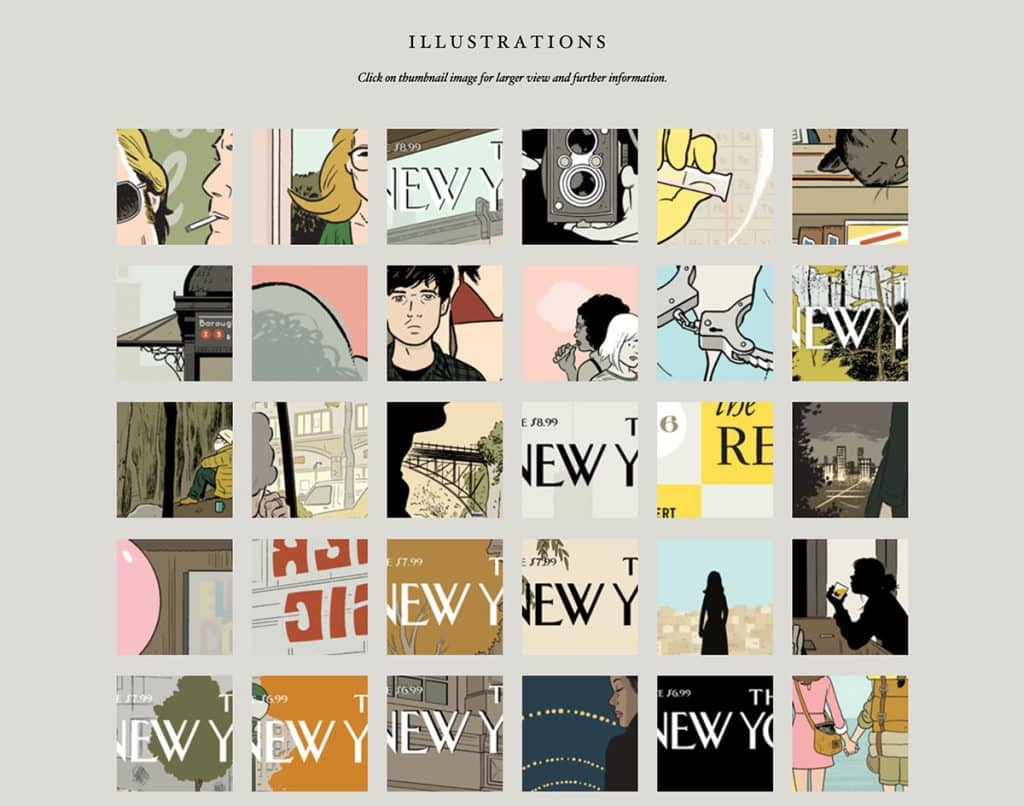
Meanwhile, the American illustrator Jonathan Bartlett organizes his portfolio by project. Each category features a striking cover image and a brief yet impactful caption designed to capture visitors’ attention.
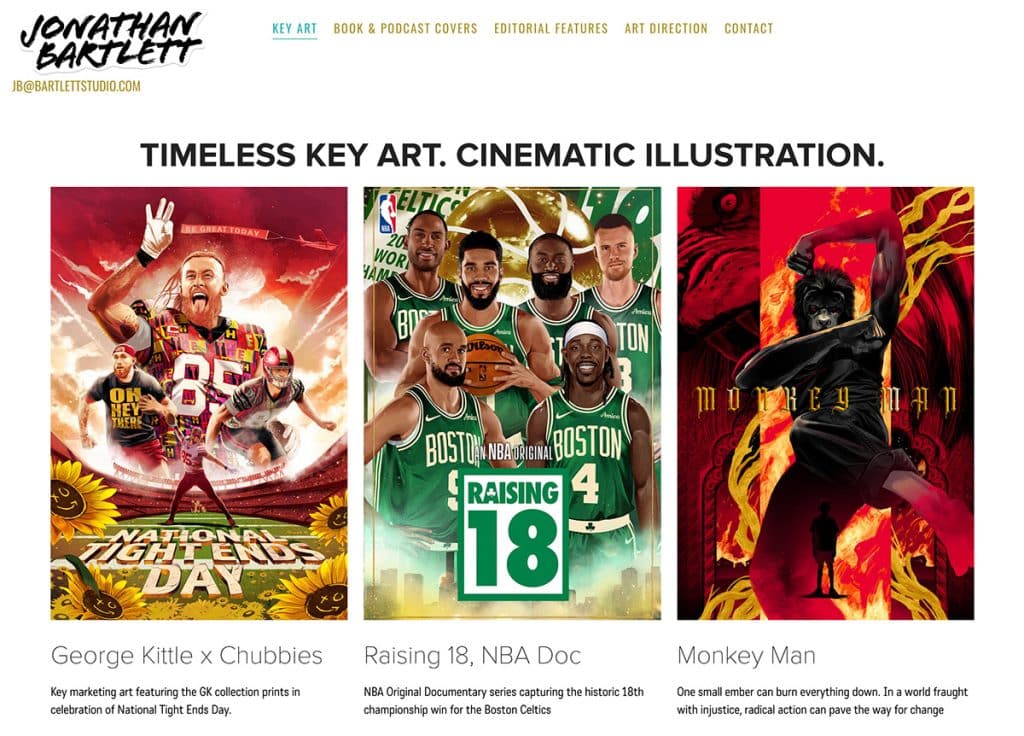
The caption for his “Monkey Man” piece reads, “One small ember can burn everything down. In a world fraught with injustice, radical action can pave the way for change.” Consider using Bartlett’s approach for your own portfolio by combining visuals with thoughtful descriptions.
Creating a Portfolio That Represents Your Best Self
It’s easy to get caught up in creating the perfect portfolio, but don’t lose sight of yourself. Select pieces that reflect your authentic passions and style. If you love illustrating adorable woodland creatures and plants, let them take center stage in your portfolio. Or if you’re passionate about futurist art, don’t be shy about including it. Otherwise, you might miss out on opportunities that fit your true interests and talents.
While many artists are self-taught, a structured program can help you gain new skills and immerse yourself in the world of illustration. At Sessions College, you’ll learn traditional and digital techniques from leading experts. You’ll also study a broad range of tools, from charcoal drawing to Adobe Illustrator to cutting-edge AI technologies.
Our illustration programs also give you the opportunity to develop a professional portfolio. You’ll receive constructive feedback from your professors and peers to help you build a fantastic portfolio that showcases your developing skills.
Start an online illustration degree or certificate program in Illustration with Sessions College today. Check out our course offerings, or explore our illustrator career guide to learn more about where an illustration program can take you!
Illustration Portfolio FAQs
How Many Pieces Should be Included in an Illustration Portfolio?
Typically, an illustration portfolio should feature 10 to 20 pieces, especially if you haven’t worked on many client projects. This amount lets you display a diverse selection of projects without overwhelming visitors.
As you gain experience, your portfolio will naturally expand. However, aim to keep it between 30 or 40 pieces at most, even if you work on many projects. Remember that audiences often have short attention spans, so always prioritize quality over quantity.
Do I Need to Copyright my Illustrations?
In the United States, your original artwork is automatically copyrighted from the moment you create it. That means no one can use the illustrations in your portfolio without obtaining your permission. Some creators choose to put a watermark on their illustrations for extra peace of mind, but it’s not a legal requirement. Consider consulting a trusted mentor for advice about how to best protect your intellectual property.
How do I get my Illustrations Noticed?
Social media can help you promote your illustrations and connect with potential clients. Share your work on Instagram, Pinterest, TikTok, and other visual-based platforms. By posting meaningful content regularly and using relevant hashtags, you can steadily grow your audience and engage with art lovers.
Networking with other artists is another effective way to draw attention to your art. Attend in-person events related to illustration, such as art fairs and conventions. These events are a wonderful opportunity to share your work and meet potential collaborators.
Where are Illustrators in Demand?
Many companies hire in-house or freelance illustrators to create commercial art. For example, you might get hired to design movie posters or product packaging. These jobs can help you gain experience and learn to create art for diverse audiences.
Illustrators can also work for print publications, such as magazines and newspapers. Book publishers often hire illustrators to create art for comics and picture books. Additionally, some artists produce accurate medical illustrations for textbooks and other educational materials.

Brianna Anderson is an experienced freelance writer and college educator with a Ph.D. in English. She enjoys writing articles on education, digital marketing, the environment, healthcare, pets, popular culture, and technology. Read more articles by Brianna.
ENROLL IN AN ONLINE PROGRAM AT SESSIONS COLLEGE:

